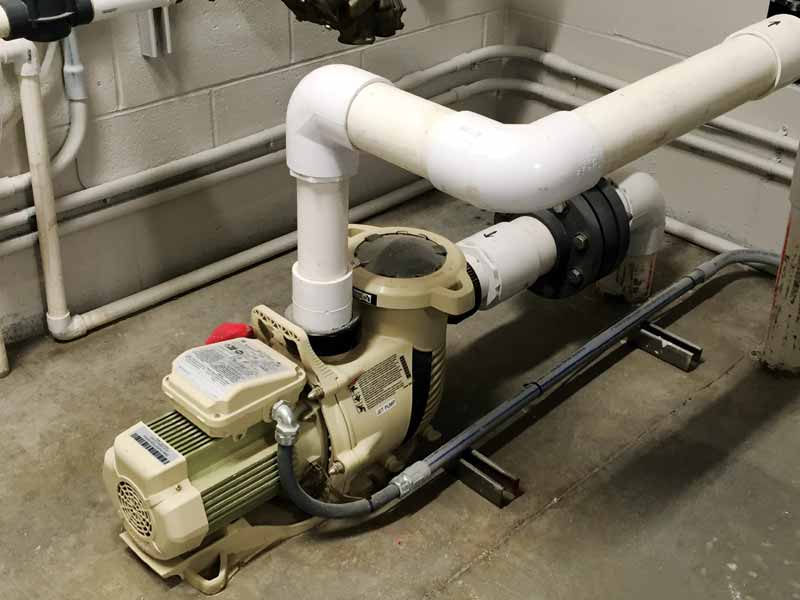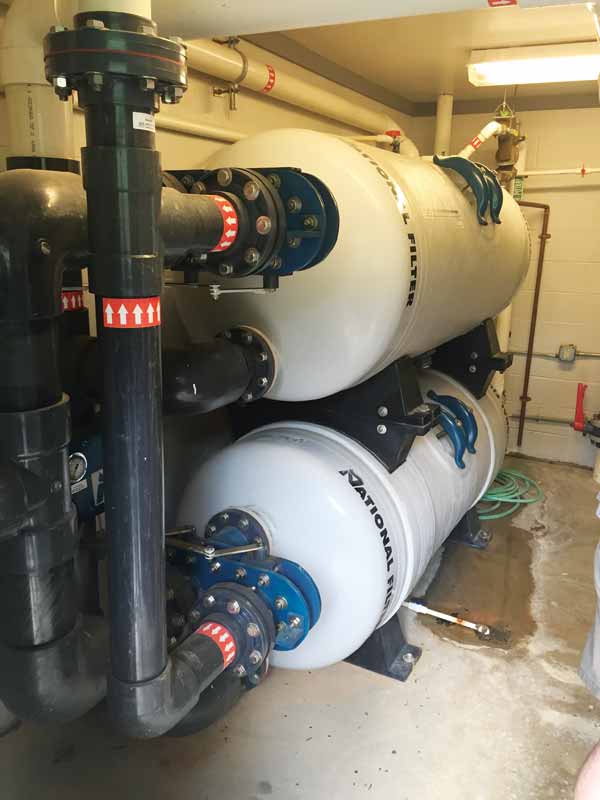VFD considerations

As the majority of commercial pump rooms have VFDs installed on all pumps, there are a few considerations when locating these new VFDs.
The location of the drive will determine whether or not it requires an enclosure that meets the electrical standards necessary for the protection of the actual drive cabinets and internal components. Whenever possible, the VFD should be installed in a location with no risk of potential harm from weather. If it has to be installed outdoors, the drive must be protected from the elements. Further, VFDs need air, so proper ventilation in pump rooms is essential.
Similar to other equipment, the drives and chemical controllers should be placed in a location that can be easily accessed by facility managers for regular programming.
UV sanitation considerations
It is commonplace for commercial pump rooms to house UV sanitation units—especially now that they are included in the recommendations of the Model Aquatic Health Code (MAHC). The size of the pool corresponds with that of the required UV unit and will also determine where it should be placed within the pump room. If the unit is for an indoor installation, it should be sized based on a 60 mJ/cm² dosage rate. This calculation will ensure the UV system eliminates pathogens that cause recreational water illnesses (RWIs). Additionally, the units will help eliminate chloramines in the pool area’s air and water, which will improve the overall air quality and bather experience.
The placement of these systems in the pump room is largely dependent on available space. Most can be installed either vertically or horizontally, and are available in low- and medium-pressure. The latter are physically smaller and, thus, do not take up as much space in the plumbing system as their counterparts. However, these systems tend to be more expensive to operate, as the replacement bulbs cost significantly more (and have to be replaced more often) than those of low-pressure systems. As such, the decision of whether to install a low- or medium-pressure system depends on the initial budget of the project, as well as the operational budget of the facility.
Heater considerations
Sufficient ventilation is key to ensuring a heater will run at its maximum capabilities/efficiencies and, thus, operate correctly. If this is overlooked, it could result in significant issues with the heater and lead to possible problems in the facility. As such, it is best to install this equipment close to the room’s ventilation points. Additionally, if water treatment products are stored in the same space, they should be kept away from the heater to avoid the risk of chemical damage.
If a pump room is small, builders should consider installing the heater outside of the room to save space. Of course, it should first be determined if the unit is rated for outdoor installation; if not, there are many heaters designed specifically for outdoor use.

Outdoor heaters have specific requirements and must be installed properly in relation to the rest of the equipment room. Further, installers should ensure these heaters are not placed under an overhang where rainwater run-off could trickle into the unit. Likewise, it is important they are not located close to window openings or under a wooden deck.
Below-grade pump room considerations
There are many physical differences inherent in a below-grade pump room when compared to one placed on the same grade as the body of water. As such, there are special considerations to be made when selecting, installing, and operating equipment for below-grade rooms.
The piece of equipment most affected is the pool pump(s). When installed below the level of the pool, a pump’s check valves must be positioned on the unit’s discharge side. This will prevent water from running backwards through the pump when it is shut off, which can cause internal damage to the equipment. Flooded-suction pumps are best for these applications.
Emergency shut-off considerations
All pump rooms must include an emergency shutoff system to pass a safety inspection. Most inspectors prefer to see these units, which allow someone to shut the system down immediately with the push of a button, in an accessible area near the pool and/or hot tub. The shutoff is usually tied into a panel that has a relay going to the main pump, causing all flow or suction to and from the pool to be stopped in case of an emergency.
In the past few years, manufacturers have added VSPs to their product lines, offering devices with suction vacuum relief systems (SVRS) built into them. If there is a suction blockage in a line, the pumps lose prime or water feeding into them, which causes them to shut off and prevent entrapment within the system.
Conclusion
When building a commercial pump room, it is important to give pumps, filters, and other equipment plenty of space to breathe. Proper, functional design can save operators money and stress in the long-run, as well as ensure a facility is running safely and efficiently.
 Mike Fowler is a commercial sales manager for Pentair in Sanford, N.C. He has been with the company since 1992, starting his career in the technical services department at Purex Pool Products. Fowler has held many managerial roles within the company, including marketing, trade show manager, and account manager. He can be reached via e-mail at mike.fowler@pentair.com.
Mike Fowler is a commercial sales manager for Pentair in Sanford, N.C. He has been with the company since 1992, starting his career in the technical services department at Purex Pool Products. Fowler has held many managerial roles within the company, including marketing, trade show manager, and account manager. He can be reached via e-mail at mike.fowler@pentair.com.






